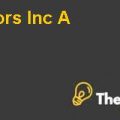INTRODUCTION
Hewlett Packard (HP) is an American multinational information technology corporation, which was founded in 1939 by Bill Hewlett and Dave Packard. HP is one of the leading companies across the globe, comprised of 150,000 employees and operates in more than 170 countries. HP provides hardware and software to Small and Medium Sized Enterprises (SMEs) and large corporations. The purpose of HP is to provide quality products and services to its customers, to gain customers and competitive advantage in the long run(Preston, 2001).
HP is traditionally leading in the area of business ethics, outstanding values and belief system known as HP way. However, under the leadership of Carly Fiorina, HP’s way strategy failed to achieve its goals and objectives. During her leadership, HP’s stock lost more than half of its value because of dot.com bubble boom and as a result, hurting most of the technology company.
Moreover, Fiorina had a negative relationship with his workers and laid off more than 30,000 workers during her time. Furthermore, Patricia destroy the company’s value by mishandling the Compaq takeover. Therefore, Fiorina’s ousted for her poor performance and thus gave her position to Patricia Dunn as a woman chairman. Patricia Dunn developed a strategy to invest boardroom leak and initiated HP pretexting, which led the company to faced pretexting scandal.
PROBLEM STATEMENT
According to the case, Carly Fiorina, the CEO, leads the company to face multiple issues and challenges regarding ethical standards, innovation, leadership and poor performance. Therefore, the company appointed Patricia Dunn as a woman chairman to further lead the company and help to increase the company’s revenue. However, Patricia Dunn became outraged with the confidential information being leaked to the media.
The HP’s board realized that their information were leaked and therefore, Patricia hired an electronic security team to spy on existing journalists, the board of directors, HP employees and other’s to get the telephone calling record, which is known as pretexting. The purpose of Patricia is to find the person who tells the company’s confidential information or secrets to journalists. However, this action was caught by the State audit and reported by the local court.
Moreover, obtaining confidential information by posing as another person is considered as unethical and leads the company to face HP Pretexting Scandal. Furthermore, the ethical issues involved in the case is the invasion of privacy, and abuse of power. Apart from that, the HP’s broad spend most of their allocated time on audit and research and as a result, the company cannot focus on their projects and faced financial and operational losses. According to the investigation team, the source of the leaks is the George Keyworth, one of the board members.
Therefore, it is essential for the firm to conduct an in-depth analysis, in order to overcome the issues faced by the company and drive possible solution and recommendations. Moreover, the company should develop ethical standards by using ethical concepts such as utilitarianism, virtue ethics approach, the right approach, and the duty of diligence.
Q. What was the problem or problems facing HP’s board of directors?
One of the main problems faced by the board of directors is how to deal with finding the source that leaking the confidential information. The board of directors led the private investigation teams to use the methods of pretexting to investigate the board of directors to find the source of the leaking. The pretexting method is used to get private information about an individual under false pretenses. Therefore, HP’s pretexting is considered as unethical because, under the California law, it is illegal to use deceit to obtain confidential information without a person’s permission. Moreover, the pretexting is considered as unethical under the Federal Telephone Records & Privacy Protection Act of 2006.
Most importantly, the issue arises is that HP’s business integrity was questioned as to information is leaked to CNET. Moreover, other ethical and illegal issues recognized in HP scandal include violation of law and moral principles, unclear information gathering policies and procedures, misconduct in corporate governance, unfair treatment towards the employees, failure of the principle code of ethics, and insider trading. Furthermore, the problems faced by the company are the lack of transparency, innovation, and leadership.
Apart from that, the problems faced by the board of directors include the lack of internal and external audit committee in investigative practices, and corporate issues, which lead the company to face conflicts and problem among the employees of the company. Lastly, the board of directors did not perform proper due diligence to hiring outside investigation companies and lack of cohesion among the board of directors in handling the situation. Therefore, it is highly important for the company to identify the issues and drive solution to gain the most competitive advantage over competitors..............
This is just a sample partial case solution. Please place the order on the website to order your own originally done case solution.













